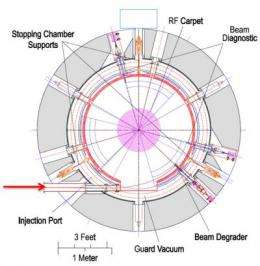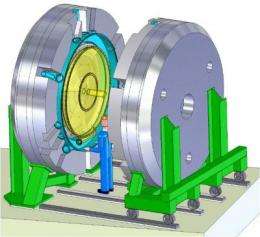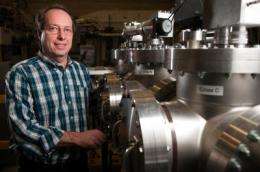Particle 'mousetrap' could help answer gnawing cosmic questions

Capturing fleeting bits of matter to reveal the nature of the universe is a little like trying to trap incredibly tiny, impossibly speedy mice alive.
A better mousetrap could be at hand, promising new insights that could bring researchers out of the woodwork to conduct cutting-edge experiments at Michigan State University's National Superconducting Cyclotron Laboratory.
Michigan State scientists landed a $3.28 million federal grant to develop an electromagnetic trap to snag and quickly extract rare isotope ricochets from high-speed particle collisions they create.
"The products we make live for much less than one second before they decay into something else, so speed is very important," explained David Morrissey, a University Distinguished Professor of chemistry and the project's principal investigator.
Rare isotopes are the unstable versions of the chemical elements found here on earth, but have too much or too little mass. Such atoms must be produced in nuclear reactions and are ionized, or electrically charged, losing some electrons that orbit the nucleus.
Stable atoms are flung together at about one-third of the speed of light by huge electromagnetic accelerators at MSU, creating rare isotopes that otherwise are only produced in stars. Based on a prototype and detailed calculations from Morrissey and his collaborators, a helium soup within a new cyclotron "decelerator" should be able to slow down and trap the speeding bits like marbles circling a bowl, slowing and separating them from the hot, gaseous whirlpool.

"We're going to provide these small ions that have never been studied before to experimenters," he said. "It will be basic research, training students and developing new technology." It also will lay useful groundwork for the half-billion dollar Facility for Rare Isotope Beams, planned for construction at MSU in the next several years.
"A large fraction of the experimental program in the future will depend on our success," Morrissey added. "We have a number of scientists here and around the country and even the world who want to come here to use the new facility," thus helping secure the future of a physics program that already leads the world in analysis of such fast projectile fragments.
Much of the MSU program focuses on mimicking the violent stellar conditions following the Big Bang, which is thought to have kick-started the universe 14 billion years ago. The engine of our own solar system, the Sun, merely fuses hydrogen atoms together to produce helium and energy. So, scientists wonder, where did the rest of the stuff here come from - the copper, the carbon, the cheese nibbled by mice?

"There are chemical elements on earth that couldn't have been made in the Sun, so they had to be made somewhere else and yet end up here," Morrissey said. The best guess, he added, is that they were formed from different kinds of stars. But because many such elemental precursors lived for only an instant, scientists must muster huge physical forces to deconstruct today's elements to figure out how they were made.
Michigan State's funding agreement with the National Science Foundation, which made the three-year grant, calls for the university to contribute $1.4 million, primarily in the form of expert manpower. The NSF funds are part of the $15 billion scientific research component of the American Recovery and Reinvestment Act, known as the federal economic stimulus program. Compensation for participants - faculty, scientific staff and engineers, postdoctoral researchers, graduate and undergraduate students - will account for $1.38 million, and permanent equipment for $1.13 million of projected expenses.
Provided by Michigan State University















